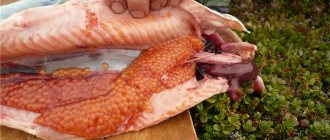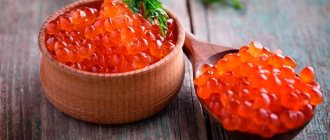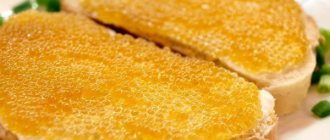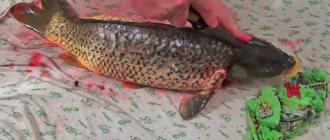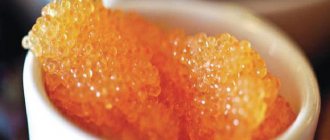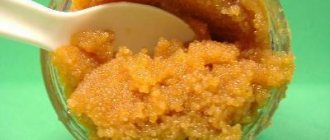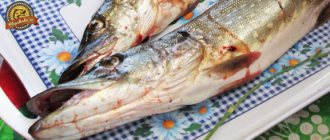What does bream look like and where is it found?
Bream fish has a specific body shape, which makes it easy to distinguish it from other inhabitants of the aquatic environment. The main external characteristics include:
- tall body compressed on both sides;
- brown, brown or golden sides;
- gray fins with dark edging;
- a small head with large eyes and a mouth that extends like a tube.
It is found in lakes, ponds, rivers, as well as in salty sea waters. The main condition for the habitat of useful fish is the presence of a large amount of algae at the bottom. Bream feeds on aquatic plants, gastropods and bivalves, and worm larvae.
Habits and nutrition
The habits of bream are quite conservative and predictable. Being a schooling fish, it prefers a sedentary lifestyle in rivers, reservoirs and lakes with weak currents and well-warmed water. At the same time, this species can successfully acclimatize in cold water bodies and slightly saline bays. Bream living in the sea are forced to lead a semi-anadromous lifestyle and rise up rivers to spawn and feed.
When examining in detail the question of what small and large bream eat, you can immediately notice a special love for cereals, small crustaceans, mollusks and various boneless organisms: worms, larvae, insects, etc. There are also cases when an adult grabs a fry. The fish spends most of its time at the bottom, choosing deep and silty places.
During sunny periods it rises closer to the surface to bask, but at the slightest noise or threat it immediately goes deeper. It is her timidity and caution that are the main factor complicating fishing.
In autumn, the habits of bream change. Due to the short length of the day and lower water temperatures, it switches from morning and evening feeding to constant feeding in order to quickly accumulate a sufficient supply of fat for the winter. In October, the habits of bream once again undergo dramatic changes - the fish gather in large schools and little by little go to the depths for wintering, but at the same time retain their appetite. This explains the possibility of successful winter fishing for both white bream and large bream.
To learn more:
How to catch bream with lard: preparing bait and tackle
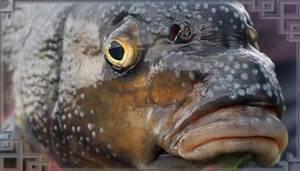
Chemical composition of bream
The beneficial properties of bream are due to the presence of various vitamins and minerals in its composition, which have a beneficial effect on the body and normalize vital processes.
| Vitamins | Minerals | ||||
| macronutrients | microelements | ||||
| A | 30.0 mcg | Potassium | 265 mg | Iron | 0.3 mg |
| Retinol | 0.03 mg | Phosphorus | 220 mg | ||
| Niacin | 3.0 mg | Calcium | 25 mg | ||
| IN 1 | 0.12 mg | Sodium | 70 mg | ||
| AT 2 | 0.1 mg | Magnesium | 30 mg | ||
| E | 1.0 mg | Sulfur | 171 mg | ||
| WITH | 1.0 mg | ||||
| RR | 6.2 mg | ||||
The high content of vitamin PP (31%) and phosphorus (27.5%) determines the successful course of all physiological processes, regulation of water-salt balance, mineralization of bone tissue and improvement of the condition of the skin.
Calorie content of bream
Fish is very satisfying and nutritious due to its high content of easily digestible protein and a small amount of fat. But the calorie content of bream per 100 grams may vary depending on the cooking method.
| Product | Calorie content (kcal) | Proteins (g) | Fat (g) | Carbohydrates (g) |
| Fresh | 105 | 17.1 | 4.1 | 0 |
| Dried | 221 | 42 | 4.5 | 0 |
| Boiled | 126 | 20.9 | 4.7 | 0 |
| Fried | 128 | 13,7 | 10,5 | 3,7 |
| Hot smoked | 172 | 32.8 | 4.5 | 0 |
| Cold smoked | 160 | 29.7 | 4.6 | 0 |
Healthy fish contains protein, which contains all the amino acids necessary for the human body, namely methionine. This component is of great importance for people suffering from heart and thyroid problems.
Description
Bream caviar is considered one of the best types of small fish caviar. This product is simple and unique. The caviar of this well-known representative of carp fish is in no way inferior to red caviar, which is considered a real delicacy.
This product, rich in vitamins and nutrients, is, in principle, dietary. Many representatives of the fair sex have wondered whether it is possible to eat this seafood without fear for their figure. It contains a large amount of protein with a relatively low calorie content of the product (142 kcal per 100 g). Therefore, eat bream caviar without looking at its calorie content. After all, it does not cause any harm to the figure.
How does the process of spawning occur in bream? It's quite simple. Spawning, the process by which fish lay eggs, begins when they reach sexual maturity. For bream it occurs at the end of spring - beginning of summer. At the same time, an external modification of the fish also occurs: an increase in black pigment leads to the fact that the scales of the bream become significantly darker and become covered with pimples, similar to a rash. The spawning process is divided into several stages, each of which lasts from six to nine days. Interesting fact: small individuals spawn first, and only then large ones. The most suitable places for spawning are those in which there is tall grass or even reeds, algae or any other vegetation. In rare cases, bream undergoes the spawning process in small bays or rivers. If the weather is favorable and clear, then the entire school goes through this stage in 3-4 days; in any other situation, the fish goes to depth, and the process is delayed.
Externally, bream caviar looks like small regular yellow balls (see photo). Since bream belongs to a subspecies of prolific fish, during one spawning period it can lay on average about one hundred thousand eggs, preferring spring flood places for this.
Why is bream useful?
The health benefits of bream were known to our distant ancestors. Therefore, the product is regularly consumed to improve well-being and strengthen the immune system. Fish should be included in the diet because it:
- quickly digested and absorbed by the body;
- normalizes life processes at the cellular level;
- reduces the risk of cardiovascular diseases;
- helps in the fight against excess fat;
- regulates blood glucose levels;
- has a beneficial effect on the condition of the mucous epithelium;
- accelerates enzymatic reactions;
- has a positive effect on the formation and regeneration of bone tissue.
In order for nutrients to bring maximum benefit and minimum harm, it is necessary to consume exclusively fresh fish, avoiding frozen products.
The benefits and harms of bream caviar
Bream caviar is a source of unique beneficial properties due to its high content of iodine and vital fatty acids. Its benefits extend to many systems, and especially:
- circulatory, excluding the occurrence and exacerbation of atherosclerosis;
- nervous, reducing the likelihood of breakdowns and stress;
- digestive, normalizing metabolism.
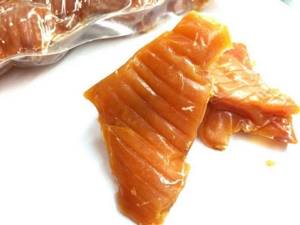
Having a balanced chemical composition and a significant content of healthy proteins, bream caviar can lead to a reduction in excess weight, despite its high calorie content.
Important! The product can cause harm in case of excessive use and individual intolerance. Children under 3 years old are not recommended to include bream caviar in the menu.
How to cook bream caviar at home?
You can prepare bream caviar at home in various ways and using many recipes. Not all housewives know what to do with bream caviar and how to cook it correctly. Thanks to this truly healthy product, you get very tasty and delicious dishes that will become a real decoration for your holiday table. You can experiment with bream caviar in any way you like: fry it in a frying pan, salt it, or cook it dried. In any case, it will turn out extremely tasty and moderately healthy. Bream caviar dishes are unique works of culinary art.
Pickling
Salting is one of the most common options for preparing this seafood. Properly salted bream caviar is a delicacy with a truly unique and distinctive taste. Salted caviar is a completely ready-made unusual appetizer, but it can also be an addition to another dish.
The main stage of product preparation will be the process of freeing each egg from a kind of protective film. This process can be called in one simple word - punching. If you will not be using too much caviar for drying, then you can use a very ordinary colander; as an alternative, a sieve or even a vegetable grater will do.
One of the simplest and most common recipes for pickling bream caviar is to place it in a bowl, add salt, mix and let it sit for a while. When the process is completed, the caviar can be served. As you can see, salting caviar is not that difficult. Please note that this method of harvesting caviar may not be completely safe, because various parasites may remain in the product, which can cause harm to the body. So be careful.
The benefits of dried and smoked bream
According to established tradition, dried bream is consumed with beer during cultural recreation. But in fact, it is an independent product that has many useful properties, namely:
- strengthens blood vessels and reduces the risk of coronary disease;
- normalizes metabolic processes;
- eliminates problems of bone tissue and teeth;
- has a bactericidal effect;
- has a positive effect on the condition of the skin and mucous membranes.
The dangers of dried bream are its significant salt content, so abuse of the product is contraindicated. Also, improperly dried fish can cause poisoning or indigestion.

Smoking preserves many beneficial vitamins and minerals that have a positive effect on the human body, providing:
- no problems with the circulatory system;
- acceleration of metabolism;
- eliminating loss of strength and energy;
- normalization of the urinary system;
- good skin condition.
Attention! The harm of smoked bream lies in the likelihood of developing cancer cells due to the presence of carcinogens, the amount of which depends on the smoking method.
Bream caviar at home
After purchasing caviar or removing it from the fish’s body, the processing process begins. The egg sacs are carefully washed, thoroughly removing blood and mucus.
The further process depends on how the caviar will be salted.
Two salting options:
- Pickling in bags
- Salting of caviar, freed from shells.
When salting in the second way, the caviar is freed from its shells. The easiest option is to rub the caviar through a sieve or brew the caviar with boiling water.
Main ingredients for salting:
For 300–500 g of caviar
Salting bream caviar in bags
If parasites are not scary and the specific taste and smell of the product does not scare you away, then do not undertake heat treatment. Caviar is salted along with the film in which nature packages it. Many people are convinced that large amounts of salt kill all parasites.
The caviar bags are placed tightly in a salting container. Sprinkle generously with salt. Then they put the second row and pour it again. Adding spices is optional. Usually the rows are lightly sprinkled with ground black pepper, but you can limit yourself to just salt. A rigid material is placed on each row.
The salted caviar is put in the refrigerator for a day. Then the excess salt is washed off, the pieces (flat dark-colored tiles) are slightly dried. After drying or wilting, they are ready to eat. It makes a delicious snack.
How to cook delicious bream
There are many ways to prepare fish, but the most popular are frying and baking in the oven, and recently also marinating. For supporters of a healthy diet, steamed fish is perfect. Nutritionists say that it is most beneficial to eat dried or sun-dried bream, since such culinary processing preserves the maximum amount of beneficial properties. For cooking, it is best to use spices such as lemon juice, suneli hops and herbs.
Bream recipe in foil
A tasty and healthy dish that is very easy to prepare. To do this you will need the following ingredients:
- 2 large bream;
- 1 large onion;
- 1 bell pepper;
- 1 carrot;
- salt, pepper, herbs to taste.
We recommend reading: The benefits and harms of leeks
Cooking method:
- Cut, clean the fish and salt and pepper on the outside and inside.
- Thoroughly mix the chopped onion, bell pepper, parsley and grated carrots.
- Place the foil on a baking sheet and carefully arrange the fish so that there are vegetables on top and below it.
- Wrap everything on top with foil and place in an oven preheated to 100 degrees for 45 minutes.
We recommend reading: Benefits of bell pepper, properties
Detailed recipe:
Second recipe for bream caviar
A more spicy recipe for bream caviar consists of a set of spices, water, preferably boiled, and one fish. The algorithm is as follows:
- Place the cleaned caviar, thoroughly washed in water, in a colander to dry it a little. All steps for preparing the main ingredient are repeated as in the recipe above;
- Boil water, from 0.5 to 1 liter, with spices. You can use coriander, a mixture of peppers and a little bay leaf. Boiling should be carried out for 20 minutes with the addition of salt;
- After removing from heat, dip the caviar into the marinade and let it sit for 20 minutes. After slightly changing the color, the finished dish can be placed in jars.
These two fairly simple recipes allow you to understand how to pickle bream caviar at home quickly and without much physical and mental effort. It is perfect for sandwiches, which can be served both at home gatherings and at large feasts.
Popular publications
latest comments
Every true fisherman must be able to not only catch fish, dry it and dry it, but also salt the caviar himself. After all, properly salted fish roe is a real delicacy. In addition, homemade caviar is very healthy due to its naturalness and high nutrient content. In this article we will talk about the technology for salting fish roe at home and provide several detailed recipes that will help you prepare an amazingly tasty appetizer.
How to properly remove caviar from fish
You can use caviar for salting only if the fish is fresh enough. To remove the caviar, you need to act very carefully and accurately. First we cut the belly of the fish. Then, with our fingers, we pick up the elongated shell bags with caviar and slowly separate them from the cavity of the fish. It is very important to remove the caviar in one piece, since if handled carelessly, bitter bile may get into the caviar. Oysters are separate egg parts covered with a thin film, the internal filling of which plays a binding role for the eggs.
Preparing caviar for salting
Caviar from pike, roach, perch, carp, rudd, bream and crucian carp is ideal for salting. To prepare the appetizer we will need at least 150 grams of caviar. The main preparatory stage is the release of the eggs from the film. This procedure is called "punching". Since we are working with a small amount of caviar, for these purposes you can use a colander, a sieve or a vegetable grater with non-sharp hole edges. The larger the eggs, the larger the holes in the dish should be so that the eggs can pass through them freely. But the process of caviar cleansing is much faster if we use a colander. Having selected the necessary dishes, we begin to slowly and carefully wipe the caviar, after cutting the film with a knife. If the total weight of the caviar is more than 2 kg, then it is better to peel it on a kitchen board using a knife (the back of it).
Harm of bream and contraindications for use
The product does not have any significant contraindications that could cause significant harm to the human body. But the possibility of a negative impact on some functions of organ systems cannot be ruled out due to:
- individual intolerance to the product;
- the presence of parasites in the body of the fish;
- a large number of small bones;
- accumulation of harmful substances when bream stays in polluted waters.
The benefits of fish significantly outweigh the harm, but you should still be careful when choosing and preparing bream to protect yourself from negative consequences.
How to salt pike caviar
Home-salted pike caviar is an exquisite delicacy. Pike caviar is in no way inferior in taste to recognized delicacies, and we can talk endlessly about its benefits. Unlike black and red caviar, it is considered more dietary due to its low fat content, but the benefits of pike caviar are its high content of protein, microelements and vitamins A and D. In Rus', pike caviar was eaten with pancakes, and it was highly valued. Every angler should have several recipes for salting pike caviar at home.
Recipe 1 To pickle caviar , you will need:
- pike caviar – 550 grams, salt – 2 tablespoons, vegetable oil – 10 ml.
Recipe for salting pike caviar: Rinse the pike thoroughly and carefully remove the caviar in bags. Rinse the pike caviar and remove the eggs from the bags, making sure that there are no remaining film residues in the caviar. Add salt to the caviar and whisk thoroughly with a fork until the salt has dissolved - approximately 20 minutes. Pike caviar is ready for salting as soon as a white foam appears. Now add 2/3 of the vegetable oil to the caviar and mix well. Place the caviar in a glass jar or saucepan, and pour the remaining oil on top. Cover the container tightly with a lid and refrigerate for 5 days. Pike caviar prepared according to this recipe is ready to eat in five days.
Recipe 2
If you are impatient to enjoy the taste of home-salted pike caviar, then take note of this simple and quick recipe for salting pike caviar .
To pickle caviar you will need:
- pike caviar – 300 grams, water, salt.
A simple recipe for quick salting of pike caviar: Without removing the pike caviar from the bags, place it in a deep bowl and use a fork. Pour 1.5 liters of boiling water into the caviar and stir it for another five minutes, removing the films. Drain the hot water and pour cold water over the caviar, drain again, stirring and removing the films. Washing the caviar requires thorough and long-lasting procedures; it may take 10 procedures or even more. After this, the caviar should be dried. Salt the dried caviar to taste and stir until the salt dissolves. The caviar can be transferred to a jar and stored in the refrigerator. After 6 hours it is ready to eat.
How to choose and store bream correctly
A healthy product must be not only fresh, but also natural, without chemicals and other components that cause significant harm to the body. Fish food contains various dyes, antibiotics and stimulants. Natural fresh fish is characterized by:
- pale meat;
- well developed fins;
- faint marine odor of iodine;
- shiny and elastic scales;
- bright, bulging eyes;
- light, without yellowish gills;
- elasticity when pressed.
Important! The supplier should store the fish in a container with ice for better cooling.
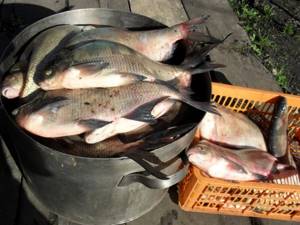
The optimal storage temperature for the product is 0 0C, and in the refrigerator it is usually +5 0C, so you need to store fish in a separate container with ice cubes. If storage is planned in large quantities, then the product must be frozen, but before that, carefully cut, wash and dry.


